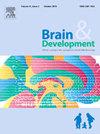日本的第一例Al-Raqad综合征与纯合子DCPS外显子变异有关,导致异常剪接
IF 1.3
4区 医学
Q4 CLINICAL NEUROLOGY
引用次数: 0
摘要
背景不明原因的神经发育障碍(NDD)常伴有多种先天性异常。随着遗传分析技术的进步,全外显子组测序(WES)已成为不明原因NDD患者的有力诊断工具,但有时会在其中检测到未知意义的变异。方法swes在一名2岁的NDD男孩中发现了一种变异,该男孩与多种先天性异常相关,g带和阵列比较基因组杂交(阵列CGH)未发现异常。利用患者外周血白细胞进行mRNA分析,以确认其对剪接的影响。结果ses检测到一种新的未知意义纯合单碱基取代变异(VUS),该变异由患者父母杂合携带(DCPS, NM_014026.6: c.200A>;G, p.(Lys67Arg))。硅分析预测该变异可能导致异常剪接,mRNA分析显示外显子1的3 '端有48bp的缺失。已知DCPS的双等位基因变异会导致Al-Raqad综合征,这是一种非常罕见的疾病,表现为NDD伴有多种畸形。据报道,这种疾病只发生在来自五个中东或高加索家庭的八个人身上,但从未发生在日本人身上,但本病例的症状与报告的这种综合征病例相似。我们成功地通过WES和mRNA分析将一例不明原因的NDD诊断为Al-Raqad综合征。单碱基取代与判断的VUS可能是致病的,通过引起异常剪接,因此,在硅分析和随后的RNA序列是必要的,以证明其致病性。本文章由计算机程序翻译,如有差异,请以英文原文为准。
The first case of Al-Raqad syndrome in Japan is associated with a homozygous DCPS exonic variant resulting in aberrant splicing
Background
Cases of unexplained neurodevelopmental disorder (NDD) are often accompanied by multiple congenital anomalies. With recent advances in genetic analysis technology, whole-exome sequencing (WES) has become a powerful diagnostic tool for unexplained NDD patients, but variants of unknown significance are sometimes detected in them.
Methods
WES identified a variant in a 2-year-old boy with NDD associated with multiple congenital anomalies who had no abnormal findings in G-banding and array comparative genomic hybridization (array CGH). mRNA analysis was performed on the variant using the patient's peripheral blood leukocytes following in silico analysis to confirm its effect on splicing.
Results
WES revealed a novel homozygous single base substituting variant of unknown significance (VUS), which was carried heterozygously by the patient's parents (DCPS, NM_014026.6: c.200A>G, p.(Lys67Arg)). In silico analysis predicted that this variant may cause aberrant splicing, and mRNA analysis revealed a 48-bp deletion from the 3′ end of exon 1. Biallelic variants of DCPS are known to cause Al-Raqad syndrome, a quite rare disorder which presents NDD with multiple malformations. This disease has been reported in only eight individuals from five Middle Eastern or Caucasian families but never in the Japanese but the symptoms of the present case were similar to reported cases of this syndrome.
Discussion
We successfully diagnosed a case of unexplained NDD as Al-Raqad syndrome by WES along with mRNA analysis. Single base substitution with judged VUS can be pathogenic by causing aberrant splicing and, therefore, in silico analysis and subsequent RNA sequence are necessary to prove its pathogenicity.
求助全文
通过发布文献求助,成功后即可免费获取论文全文。
去求助
来源期刊

Brain & Development
医学-临床神经学
CiteScore
3.60
自引率
0.00%
发文量
153
审稿时长
50 days
期刊介绍:
Brain and Development (ISSN 0387-7604) is the Official Journal of the Japanese Society of Child Neurology, and is aimed to promote clinical child neurology and developmental neuroscience.
The journal is devoted to publishing Review Articles, Full Length Original Papers, Case Reports and Letters to the Editor in the field of Child Neurology and related sciences. Proceedings of meetings, and professional announcements will be published at the Editor''s discretion. Letters concerning articles published in Brain and Development and other relevant issues are also welcome.
 求助内容:
求助内容: 应助结果提醒方式:
应助结果提醒方式:


